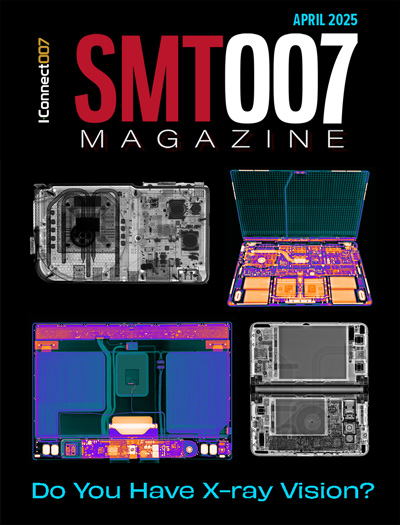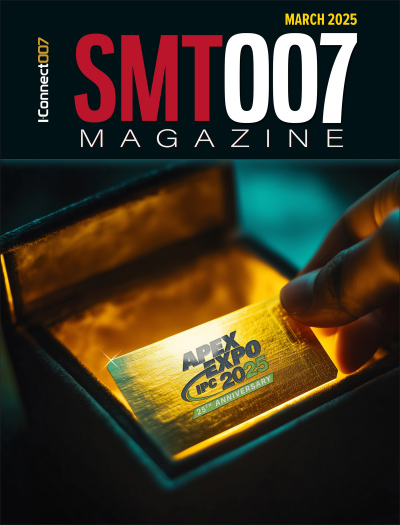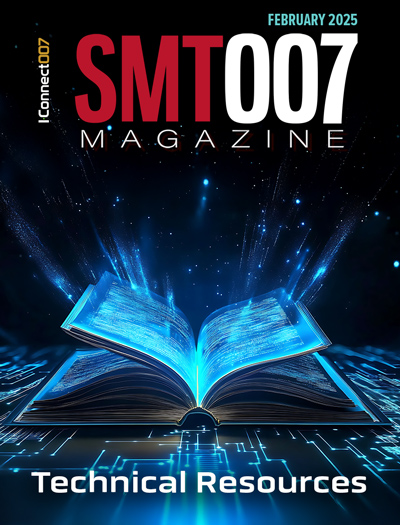-

- News
- Books
Featured Books
- smt007 Magazine
Latest Issues
Current Issue
Do You Have X-ray Vision?
Has X-ray’s time finally come in electronics manufacturing? Join us in this issue of SMT007 Magazine, where we answer this question and others to bring more efficiency to your bottom line.

IPC APEX EXPO 2025: A Preview
It’s that time again. If you’re going to Anaheim for IPC APEX EXPO 2025, we’ll see you there. In the meantime, consider this issue of SMT007 Magazine to be your golden ticket to planning the show.

Technical Resources
Key industry organizations–all with knowledge sharing as a part of their mission–share their technical repositories in this issue of SMT007 Magazine. Where can you find information critical to your work? Odds are, right here.
- Articles
- Columns
Search Console
- Links
- Media kit
||| MENU - smt007 Magazine
Line Efficiency and Productivity Measures
December 31, 1969 |Estimated reading time: 7 minutes
Data from both OEM and CM SMT lines were collected and analyzed to determine line efficiency, nonproductive assembly time and other productivity measures.
By Charles-Henri Mangin
The assembly of printed circuit boards (PCB) is a capital-intensive activity that generates revenue only when the lines are producing fully populated, working printed circuit assemblies (PCA). Measuring the output of assembly resources is the subject of continuous benchmarking exercises. A common metric, capacity utilization, is computed by reference to a level of production that is known to be achievable but not necessarily world-class. For this reason, capacity utilization is considered a "soft" number and line efficiency is considered a far more robust measure.
Line efficiency is the ratio of the number of hours during which a high-volume pick-and-place machine actually places parts on the PCB divided by the number of hours during which the SMT assembly lines are staffed (placement time/staffed time x 100). It is a hard number, simple to obtain, and has great value as a performance indicator.
The controller of most chipshooters records when they are placing parts and when they are idle. Therefore, reliable data is commonly available for placement time. Staffed hours can be more delicate to count, especially when shifts are staggered and the lines are operated fewer than 24 hours a day. A partially manned line, meals and breaks count as staffed hours, even though the line may stop and the time may not be paid to the employees during the latter situations. Highly efficient facilities do not interrupt production for breaks. Meetings for shift changes are counted as part of the staffed hours. Although there might be a valid reason for not operating the lines, all staffed hours are counted.
Because of this methodology, the line efficiency ratio is not overstated and is more consistent across the industry because it does not allow manipulation. CEERIS applies the same type of definitions for its computation of defects per million opportunities (DPMO) and conversion costs or cost per placement (cpp) in other benchmarking reports.
A detailed investigation at a sample of factories shows that in the realm of hard data, line efficiency is a reliable indicator of line utilization, but it should be complimented by other measures to assess overall factory productivity such as output per head count or pick-and-place.
Sample SelectionEarlier this year, CEERIS assembled data on line efficiency, nonproductive assembly time and other important shop floor productivity measures for 19 factories and 100 SMT lines.1 The sample includes seven operations and 28 SMT lines from original equipment manufacturers (OEM) and 12 plants and 72 SMT lines from contract manufacturers (CM). These 100 SMT lines assemble nearly 15 million PCAs per year, totaling close to 4 billion components. The 19 assembly facilities employed more than 7,000 direct and indirect laborers.
Of the CM factories included in this benchmarking exercise, 10 belong to the largest companies in the sector, one is a second-tier operation with respect to dollar volume but a recognized technology leader, and one is a low-volume factory. As for the captive assembly plants, they belong to well-known corporate names and are constantly benchmarked against the competition the independent CMs.

Line EfficiencyFor the sample of 19 factories, the average line efficiency is 52 percent, which means that SMT lines are not placing components 48 percent of the time even though they are staffed (Table 1). The median is also at 52 percent, indicating that half of the facilities are performing above the average for the group.
At the factory level, the world-class value for line efficiency is equal or superior to 65 percent. This is an average for all assembly lines operated by a factory, with high-volume lines achieving above 80 percent efficiency and high-mix lines in the 60 percent range. Also, the world-class efficiency is typically at 75 percent for single lines, but reaches above 80 percent for double lines capable of assembling two sides of a PCA continuously. CEERIS knows of assembly operations with notably higher performances; therefore, the selected world-class level is certainly feasible. Because the facilities included in this benchmarking program are operated by some of the most well-known and respected CMs, their achievements are deemed adequate references for the overall market.
For the 72 SMT lines operated by the CMs in the sample, the average line efficiency is 54 percent; these lines are staffed 112 hours per week with the volume pick-and-place machine assembling parts on PCAs 63 hours per week. The OEM sample (28 SMT lines) averages 101 hours per week of staffed time and 45 hours per week of pick-and-place time, producing a line efficiency of 46 percent. The substantial difference in line efficiency at OEMs and CMs only provides a partial picture of the global productivity of these two groups in the sample.
ProductivityLine efficiency is an incomplete measure of productivity because it does not incorporate duration. The ratio is based on the actual staffed time, not the optimum or maximum time. It does not consider the use of labor. Of course, market demand sets the volume of PCAs a factory is requested to assemble during a given period of time; therefore, productivity is subject to outside forces. A primary reason for OEMs to outsource is to avoid the risk of owning unused capacity, thus the importance of adjusting resources to volume requirements and assessing productivity.
Output per employee, per pick-and-place or per hour of machine time are among the metrics representative of shop-floor productivity. Table 2 compares the performance of the OEMs and CMs in the benchmarking sample.
On most SMT lines, there are machine operators and inspectors checking PCBs for potential defects. The operator often performs some inspection tasks, such as post-screen printing. For these reasons, the output per direct labor on an assembly line is computed by dividing the number of components assembled yearly by the number of machine operators plus inspectors.
The average yearly assembly volume per machine operator/inspector is 4.6 million SMT components for the whole sample, 4.4 million for OEMs and 4.7 million for CMs. The CMs operate their assembly lines for more hours with faster machines at higher efficiency than the OEMs in the sample. Of the volume pick-and-place at CMs in the sample, 36 percent are of the very high-volume type vs. 2 percent at the OEMs. It is not surprising that CMs assemble more components yearly per operator/inspector than OEMs. But the CMs' advantage over OEMs on line efficiency performance might be achieved with higher head counts that would negatively impact the cost structure.
The number of components assembled per pick-and-place machine per staffed hour averages 2,340 for the entire sample. It reaches 2,480 at OEMs and is 2,300 at CMs. Even though the OEMs in the sample do not operate very high-speed pick-and-place machines and lag with respect to efficiency, they slightly outpace CMs. Bottlenecks are not as big a reason for pick-and-place slowdowns at OEMs because of the distribution of the mix of pick-and-place machines on the lines and line configurations.
The number of placement hours refers to the hours the volume pick-and-place places components on the PCA. The average output per placement hour is 4,450 components per pick-and-place machine for the entire sample. It reaches 5,620 components on average at OEMs and averages 4,150 at the CMs. In this sample, OEMs benefit from better line configurations than CMs. For example, for single lines, 85 percent of the CMs' lines are based on two pick-and-place types: high-volume and high-accuracy. By comparison, only half of the OEMs' lines have two pick-and-place types, while 31 percent use three and 11 percent use four. Having more than two autoplacers on an SMT line enhances productivity.

ConclusionLine efficiency is an essential measure of productivity that can be complemented by other metrics such as those presented in Table 2, providing a more thorough evaluation of performance. A detailed analysis highlights the causes of lagging productivity and provides strong clues for potential improvements.
Competitive shop floors should achieve the line efficiency and output per operator/inspector of the CMs and, at the same time, the throughput per pick-and-place of the OEMs. This implies reducing the head count per line and increasing the number of volume pick-and-place per line at the CMs. With better line configurations, CMs will reduce the negative impact of bottlenecks. For OEMs, the recommendation is to improve line efficiency either through increased volume or with a reduction of the number of lines for the existing volume.
Line configuration is a major element of productivity. Double lines and single lines with multiple pick-and-place machines are still too rare. Line efficiency can identify bottlenecks and nonproductive time, which provides directions as to the optimum line configuration for a given assembly environment.
REFERENCE1 "Line Efficiency and Assembly Environment Benchmarking Study," CEERIS Report LE.
CHARLES-HENRI MANGIN is president of CEERIS International Inc., P.O. Box 939, Old Lyme, CT 06371; (860) 434-8740; Fax: (860) 434-8742; E-mail: CHMangin@CEERIS.com; Web site: www.CEERIS.com.


